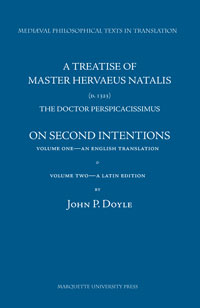44. A Treatise of Master Hervaeus Natalis (d. 1323) The Doctor Perspicacissimus on Second Intentions. Volume One—An English Translation & Volume Two—A Latin Edition, translated and with in Introduction by John P. Doyle. ISBN-13: 978-087462-247-8. Paper. 622 pp. $47.
These volumes present a first critical Latin edition and an English translation of an important, but very difficult to read and understand, medieval treatise. As almost everyone knows, the notion of intentionality comes from the Middle Ages. What is less known is that Hervaeus Natalis, OP. (d. 1323) was the first one explicitly to consider it as such. Even less known is the fact that he came to it not immediately from the Aristotelian De Anima, but rather from the division in Aristotle’s Metaphysics between “being as being” and “being as true.” Least of all known is the fact that Hervaeus, who uses the term “intentionality” in the present work 235 times, regards its significance as a relation of reason which runs in the direction of known or knowable to knower.
Apart from its exceedingly obscure Latin style, what particularly makes this work difficult to understand is its multi-layered reflection on things and non-things, its reflection on Hervaeus’ thinking itself, and its reflection on his thinking about his thinking about things and non-things.
 After 40 years teaching graduate courses in Latin Scholasticism at St. Louis University, John P. Doyle retired as Professor Emeritus of Philosophy. He is now Distinguished Professor of Philosophy at Kenrick-Glennon Seminary in Shrewsbury, Missouri. In addition to the present volumes, he has published six more volumes of translations and has produced over 50 articles, essays, and encyclopedia entries, all dealing with figures and themes in medieval and post-medieval philosophy.
After 40 years teaching graduate courses in Latin Scholasticism at St. Louis University, John P. Doyle retired as Professor Emeritus of Philosophy. He is now Distinguished Professor of Philosophy at Kenrick-Glennon Seminary in Shrewsbury, Missouri. In addition to the present volumes, he has published six more volumes of translations and has produced over 50 articles, essays, and encyclopedia entries, all dealing with figures and themes in medieval and post-medieval philosophy.






